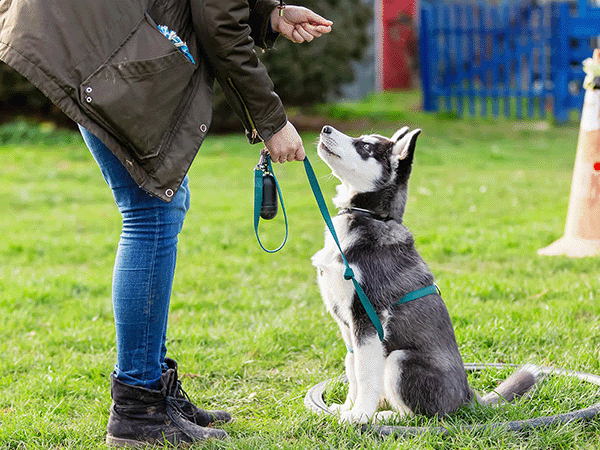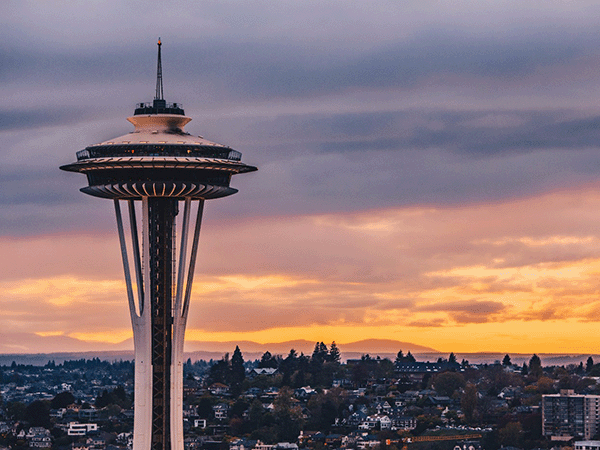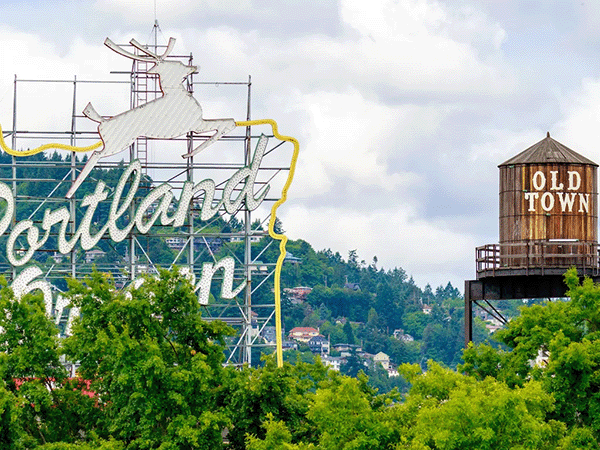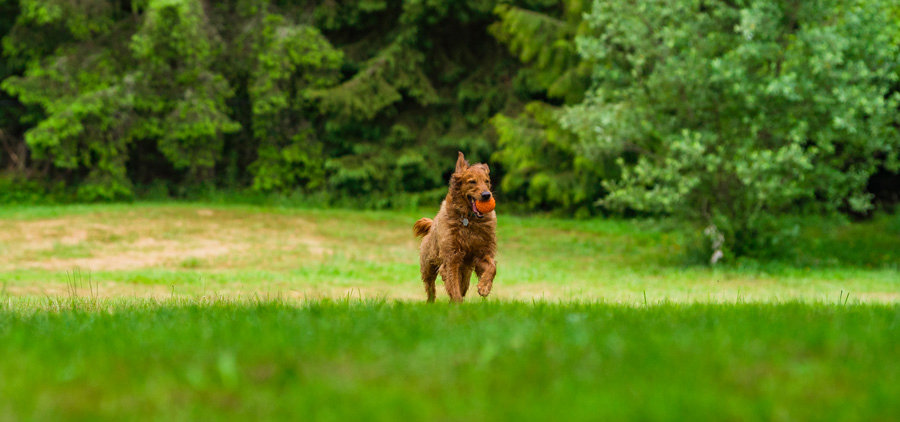Best Airlines Allowing Big Pets in Cabin

Flying with a large dog can feel overwhelming. It's tough to find airlines that allow large dogs in cabin. This guide compiles years of Sniffspot traveler experience and research to simplify how to fly with a large dog. We'll cover in-cabin challenges, cargo travel realities, plus alternative transport options. Let's make your next trip with your furry friend a smooth one.
According to our latest dog-friendly travel stats, more pet parents than ever are taking to the skies with their canine companions. But navigating airline policies for large dogs can be particularly challenging. As one Sniffspot user puts it: “Finding pet-friendly transportation options, especially for larger dogs, poses a significant challenge for travelers.”
Airline Policies for Large Dogs: A Quick Guide
- What Qualifies as a "Large Dog"?
- Airline Large Breed Restrictions
- Cabin vs. Cargo Options for Large Dogs
- Flying with Large Dogs: Cabin Travel
- Flying with Large Dogs: Cargo Travel
- Cost Analysis: The Investment of Flying with Large Dogs
- Cabin Fees (For Reference)
- Cargo Fees
- Flying with Large Dogs: Additional Expenses
- Required Equipment for Flying with Large Dogs
- IATA-Approved Kennel Requirements:
- Required Accessories
- Recommended Add-Ons
- Where to Find Approved Airline Dog Travel Equipment
- Health & Safety: Preparing Your Large Dog for the Sky
- Alternative Options: When Traditional Airlines Don't Fit
- Expert Tips for Flying with Large Dogs: Wisdom from the Sniffspot Community
- Frequently Asked Questions About Flying with Large Dogs
Key Takeaways
- Careful planning is essential for large dog air travel: Contact airlines directly to confirm their current pet policies, including size and breed restrictions, kennel requirements, and any applicable fees.
- Explore all transport options, not just cargo: While cargo is common for large dogs, consider pet-specific airlines, ground transportation services, or train travel as alternatives. Weigh the pros, cons, and costs of each option.
- Your dog's well-being comes first: Consult your vet before any flight to discuss potential health risks and ensure your dog is fit to travel. Acclimate your dog to their travel kennel and gather all necessary health documentation in advance.
Understanding Airline Policies for Large Dogs
Before you book that flight, understanding airline-specific policies is crucial for a smooth trip with your large dog. Policies vary significantly between airlines, so research is key. A little prep work can save you a lot of hassle later.
Key Considerations for In-Cabin Travel with Large Dogs
Size and Weight Restrictions
Most airlines have strict size and weight limits for in-cabin pets, often around 15 pounds. This typically excludes larger breeds. Larger dogs may need to travel as cargo, which we'll discuss later. This can be a deal-breaker for many owners of large breeds.
Breed Restrictions
Certain dog breeds face travel restrictions due to potential breathing difficulties associated with air pressure changes during flights. Brachycephalic (short-nosed) breeds are particularly susceptible. Always check with the airline about breed-specific regulations before booking.
Carrier Requirements
Airlines mandate specific carrier requirements for in-cabin travel. Your carrier must be appropriately sized, well-ventilated, padded, and water-resistant. Your dog should be able to stand, turn around, and lie down comfortably. Measure your dog carefully and choose a carrier that meets both their needs and the airline's regulations. A comfortable dog makes for a smoother flight.
Specific Airline Policies for Large Dogs in Cabin (Service/ESA)
While most airlines restrict large dogs from the cabin unless they are designated service or emotional support animals (ESAs), policies can differ. Here are a few examples to illustrate the variations:
Lufthansa
Lufthansa allows large dogs in the cabin under specific conditions, primarily for service and ESAs with advance notice. Contact them directly to confirm current requirements.
Air Canada
Air Canada permits service animals of any size and ESAs with proper documentation. Advance notice is essential to ensure a smooth check-in process.
Delta
Delta accommodates service and ESAs. Size restrictions apply, ensuring the animal fits near your seat without obstructing others. Check their website for specific dimensions.
United
United allows up to two pets per person, which may require purchasing an additional seat. Confirm their current pet policy before you fly.
American Airlines
American Airlines' policies vary based on breed and size. Cargo transport might be necessary for larger dogs, depending on the destination. Directly contacting them is the best way to understand their current rules.
Clarity on Emotional Support Animal (ESA) Regulations
Many airlines permit large dogs in the cabin as service or ESAs. However, this requires specific documentation and adherence to regulations, which have become stricter in recent years. Thoroughly research the airline's ESA policy and ensure you have the necessary paperwork well in advance of your travel date.
Understanding the Risks of Cargo Transport for Large Dogs
Why Cargo Transport Can Be Risky
Cargo transport for pets carries inherent risks. Many pet owners express concerns due to potential dangers like extreme temperatures, loud noises, and rough handling. While airlines strive to ensure animal safety, accidents can and do happen. Weigh these risks carefully when considering this option.
Researching Cargo Options Carefully (If Unavoidable)
If cargo transport is unavoidable, research different airlines and their specific cargo policies. Some airlines specialize in pet transport and offer climate-controlled cargo areas. Smaller airlines or private charters might be safer options, although they often come with a higher price tag.
International Pet and Animal Transportation Association (IPATA)
For international travel, consider using a pet shipper accredited by the International Pet and Animal Transportation Association (IPATA). These professionals specialize in safe and humane animal transport and can guide you through the often complex process. They can be an invaluable resource for navigating international pet travel regulations.
Alternatives to Flying with Large Dogs
Driving with Your Large Dog
If your destination is within driving distance, consider a road trip. Driving offers more control over your dog's environment and eliminates the stress of airport procedures and cargo holds. Plan your route with dog-friendly stops, including Sniffspot parks for safe exercise and potty breaks. This can turn the journey into a fun adventure for both of you.
Leaving Your Dog with a Trusted Caregiver
If flying presents too many challenges, leaving your dog with a trusted friend, family member, or professional pet sitter is a viable option. This eliminates the stress of travel for both you and your furry friend. Ensure your caregiver is comfortable with your dog's size and needs before making arrangements.
What We Discovered About Flying with Large Dogs
- 82% of dog owners don’t have a preferred airline for traveling with their pets
- Delta (4%), Southwest (3.6%), and Alaska Airlines (3.5%) are the most preferred airlines among dog owners for domestic flights
- 40% of respondents find traveling with dogs “much more difficult” than traveling without
- Transportation challenges rank among the top 4 difficulties when traveling with dogs
Source: Sniffspot User Travel Survey 2024
What's Considered a "Large" Dog for Air Travel?

Source: Airline Travel Policies (American Airlines)
In the airline world, a “large dog” is typically any dog that can’t fit in a travel carrier under the airline seat in front of you. For this guide, we’ll be using American Airlines as an example since it’s a good baseline for understanding large dog policies. According to this airline:
- Cabin dogs must fit in a carrier no larger than 19″ x 13″ x 9″
- Any dog requiring a larger carrier must travel in cargo
- The combined weight of the dog and carrier cannot exceed 100 pounds for cargo travel
In the cargo, pets also must be able to comfortably stand without touching the top of their carrier, turn around completely, and lie down in a normal position. It’s also important to recognize that different airlines, aircrafts, routes, and seasons have different restrictions when it comes to flying with large dogs.
Airline Breed Restrictions: What You Need to Know
When it comes to flying, your dog’s family tree matters as much as its size. Domestic airlines have become increasingly strict about breed restrictions, particularly for brachycephalic (short-nosed) breeds and those traditionally labeled as “aggressive.”
- Brachycephalic (short-nosed) breeds (Boston terriers, pit bulls, pugs, boxers, bulldogs, shih tzus, etc.)
- “Aggressive” breeds (Pitbulls, German Shepherds, Rottweilers, etc.)
- Mixed breeds containing any restricted breed
What’s the reasoning behind this?
- Health concerns: Short-nosed breeds are more susceptible to respiratory issues, high altitudes can exacerbate these breathing problems, and certain breeds are more sensitive to temperature changes.
- Safety concerns: Some breeds may become more stressed during air travel, and large breeds are more likely to damage kennels. Some airlines are also concerned about insurance and liability issues with certain breeds.
How do you work around these restrictions? For owners of anxious, extra large, or restricted breeds, consider pet-specific transportation services, charter flights, and smaller carriers. These smaller or charter services often have their own rules and flexible requirements.
Sniffspot Large Breed Owners Responses:
- “I had to get creative with transportation since my pit bull wasn’t allowed in the cabin or cargo.” (Michelle)
- “I travel in my RV with them since most places have breed restrictions for my pitbull-type dogs.” (Jessica S.)
- “Finding an airline that accommodates my 75-pound Lab has been a challenge. Most people don’t realize it’s not just about weight – it’s about height and length too.” (Sarah M.)

@K9Jets_ on Instagram: “LA Baby!”
Cabin vs. Cargo: Choosing the Right Flight for Your Large Dog
When it comes to flying with large dogs, where your furry friend travels can be one of the most stress-inducing decisions. Let’s break down both options so you can make the best choice for your big buddy.
“We’ve tried both cabin and cargo with our different-sized dogs. Each has its pros and cons, but the most important thing is knowing exactly what you’re getting into.” (Rachel K.)
Source: Airline Pet Travel Policies
Flying with Your Large Dog in the Cabin
For large dogs, cabin travel is generally not an option. However, it’s important to understand the requirements:
Unfortunately, if your dog could be mistaken for a small horse, cabin travel is probably off the table. Here’s why:
- Maximum carrier size: 19″ x 13″ x 9″ (varies by airline)
- Must fit completely under the seat in front
- Dog must be able to stand and turn around in carrier
- Weight limits typically max out at 20 pounds
Additionally, there are a limited number of pets per flight, and they’re not typically permitted in first/business class. Cabin travel also isn’t allowed for flights over 12 hours.
Acclimating Your Dog to Its Carrier
Whether your large dog flies in the cabin (if they’re small enough and meet the requirements) or in cargo, getting them comfortable in their carrier is crucial. A comfortable carrier can be a safe haven, minimizing stress during the journey. Think of it as their own little den amidst the airport hustle and bustle.
Introduce the carrier gradually. Don’t just spring it on them the day of the flight. Let your dog explore the carrier at their own pace, rewarding their curiosity with treats and praise. Place their favorite toys and blankets inside to create positive associations. Feeding them meals in the carrier can also help them view it as a safe and enjoyable space.
Practice runs are key. Short car trips with your dog in the carrier can help them acclimate to the motion and confinement. Gradually increase the length of these trips to build their tolerance. If your dog seems particularly anxious, consult with a professional dog trainer for personalized tips.
Flying with Your Large Dog in Cargo
For large dogs, cargo is often the only way to fly – but don’t let that stress you out like a cat at a dog park. While the thought of your furry friend traveling beneath your feet might make your tail droop, cargo travel is more sophisticated than many pet parents realize. Modern airline cargo holds aren’t the dark, scary places Hollywood makes them out to be – they’re pressurized, temperature-controlled spaces designed with live cargo in mind.
“We chose to drive cross-country instead of putting our large dog in cargo – the anxiety wasn’t worth it for either of us! But I know others who’ve had great experiences with proper preparation.“ (Sarah)
Cargo Requirements:
- Minimum kennel size must allow dog to stand without touching the top, turn around completely, and lie down naturally
- Maximum combined weight (dog + kennel) = 100 lbs
- Kennel must meet IATA requirements (metal door bolts, rigid sides, water bowl attachment, and ‘live animal’ stickers)
- Temperature restrictions apply (typically no travel if below 45°F or above 85°F)
- Only certain routes permit cargo travel for live pets, and there are international restrictions
For a full breakdown of what types of airlines permit cabin and cargo travel for large dogs, read our full guide to airline dog policies.
The Costs of Flying with a Large Dog
Let’s talk numbers – and no, they’re not as scary as the vacuum cleaner (though they might make you jump just as high). Flying with a large dog requires some financial planning, and the costs can vary significantly between airlines and travel options.
“The fees were definitely a shock at first, but once I broke down all the costs of alternatives like driving or pet transport services, airline travel made more sense for us.” (Amanda R.)
Sources: Sniffspot 2024 User Travel Survey
Cabin Fees: A Quick Look
While your large pup won’t be flying in the cabin, these fees provide a good baseline:
- American Airlines: $125 each way
- Delta: $95 each way
- United: $125 each way
- Southwest: $95 each way
Cargo Fees: What to Expect
Here’s where size really matters:
- 50-70 lbs: $200-275 each way
- 71-100 lbs: $250-325 each way
- Additional handling fees: $50-150
“I had to factor in not just the cargo fee, but also the special crate I needed to buy – it was a significant investment, but it’s reusable for future trips.” (Michael K.)
Hidden Costs of Large Dog Air Travel
- Airline-approved kennel ($100-400)
- Kennel accessories ($50-100)
- Travel ID tags ($10-20)
- Microchip updating ($25-45)
- Vet health certificate ($50-200)
- Required vaccinations ($75-250)
- Pre-flight check-up ($45-75)
- Pet insurance for travel ($30-100)
- Ground transportation to/from airport ($50-100)
- Extra fees for layovers
- Temperature-controlled facility fees
“The initial costs seemed high, but spreading them across multiple trips made it more manageable – especially since most of the equipment is reusable.” (Jennifer T.)
Essential Gear for Flying with Your Large Dog

Just like you wouldn’t head to the dog park without a leash and treats, air travel with your large dog requires specific gear. Consider this your ultimate packing list – Marie Kondo meets Marley & Me, if you will.
“I thought I could use our regular travel kennel for the flight. Big mistake! Airline requirements are super specific – thank goodness I checked before our trip.” (David K.)
IATA-Approved Kennel Requirements:
- Rigid plastic or metal construction (no soft carriers)
- Metal door with secure, spring-loaded locking system
- Ventilation on all four sides
- Leak-proof bottom with absorbent material
- “Live Animal” labels and directional arrows
- Food and water dishes attached inside
- Spacer bars/rims on outside
- Nuts and bolts (not just plastic screws)
Remember, your dog must be able to stand naturally without touching the top, turn around completely, and lie down comfortably. When shopping for a kennel, use this formula: length of dog (nose to tail) + 1/2 length of legs = minimum kennel length.
Essential Accessories for a Smooth Flight
- Water bowl (attachable)
- Food bowl (attachable)
- Zip ties for door security
- Absorbent padding (towel)
- ID tags on kennel
- Cable ties for assembly points
- “Live Animal” stickers
- Directional arrows (like “This side up”)
Extra Comfort for Your Canine Companion
- No-slip mat
- Pee pads
- Frozen water bottle
- Small bag of food (attached outside)
- Familiar blanket or toy
- Cleaning supplies kit
Most airlines restrict what can go in the kennel. This usually means no loose bedding, plush toys, thick blankets, or removable pads. Check your specific airline before you purchase any add-ons or extras.
“I learned that less is more when it comes to kennel comfort. A thin, secured pad is safer than cushy bedding that could shift during flight.” (Mike T.)
Finding Approved Dog Travel Gear
- Airline approved vendors
- Pet supply stores
- Airport pet supply shops
- Rental services
- Secondhand marketplaces
- Local pet parent groups
“I found a great deal on a barely-used airline-approved kennel through our local pet Facebook group. Saved hundreds!” (Jennifer P.)
Keeping Your Large Dog Safe and Healthy in the Air
Just like we wouldn’t board a flight without our passports, our large furry friends need their own set of medical credentials. And no, a clean bill of health from the local dog park gossip isn’t quite enough.
“The health certificate timing stressed me out more than packing! But once I understood the requirements, it was actually pretty straightforward.” (Lauren K.)
Health Risks Related to Air Pressure
Altitude and air pressure changes during flight can pose health risks for dogs, especially brachycephalic (short-nosed) breeds like Pugs, French Bulldogs, and Bulldogs. Their shortened airways make them more susceptible to breathing difficulties, which can be exacerbated by the lower air pressure in airplane cabins and cargo holds. This sensitivity to air pressure is a key factor in many airline restrictions.
Even for dogs without pre-existing breathing problems, the change in air pressure can cause discomfort and anxiety. Temperature fluctuations in cargo holds are an additional concern. Before flying, talk to your vet about these potential risks, especially if your dog has any underlying health conditions. Finding a qualified dog trainer can also help prepare your dog for the stress of air travel.
Required Documentation for Air Travel with Your Dog
- Health Certificate (issued within 10 days of travel)
- Proof of current vaccinations
- Rabies certificate
- State-specific health requirements
- International documentation (if applicable – check with your destination country)
Vaccination Requirements for Your Dog's Flight
- Rabies shots (with valid certificate)
- DHPP (Distemper, Hepatitis, Parainfluenza, Parvovirus)
- Bordetella (recommended for cargo travel)
Your vet should perform. pre-flight health check before you consider flying with your large dog. This includes evaluating their overall health condition, temperature tolerance, anxiety levels, physical fitness, current medications, and so on.
You should not fly with your dog if she’s in heat, extremely anxious, has recent injuries, is elderly or under 8 months, or has existing respiratory problems. Most airlines recommend against flying with a brachycephalic breed. Your vet will educate you on the health risk to your particular pup.
“Our vet actually recommended against flying our senior Great Dane – something we hadn’t even considered. It saved us from what could have been a risky situation.” (Maria P.)
Consulting a Veterinarian Before Your Trip
Bringing your large dog to the vet before a flight isn’t just about paperwork—it’s about peace of mind. Think of it as a pre-trip checkup, not just for your dog's health but for your own sanity, too.
Your vet will do a thorough check-up, evaluating everything from your dog's overall health and anxiety levels to their temperature tolerance and physical fitness. They’ll review any current medications and discuss potential travel-related health risks, especially important for brachycephalic breeds, who can experience breathing difficulties exacerbated by air travel. This pre-flight consultation ensures your dog is fit to fly.
Your vet can also offer helpful advice on managing your dog's stress during the flight. They might suggest calming aids, crate-training tips, or anti-anxiety medication if necessary. A comfortable dog makes for a smoother, less stressful travel experience for both of you.
“Our vet actually recommended against flying our senior Great Dane—something we hadn’t even considered. It saved us from a potentially risky situation.” (Maria P.)
Other Ways to Travel with Your Large Dog

Not every large dog’s journey needs to be 30,000 feet in the air. In fact, our survey shows that many pet parents are getting creative with their travel solutions. Let’s explore all your options, from luxury pet airlines to cross-country road trips.
“After checking airline restrictions for our two Great Danes, we realized we needed to think outside the cargo hold. The alternatives we found actually made our journey more enjoyable.” (Patricia M.)
Charter & Private Flights: VIP Travel for Your Pup
When commercial airlines give you pause, specialized pet airlines can help your paws fly in comfort. These services have reimagined air travel from a pet’s perspective, though availability and routes can be limited.
- Pet Airways: The pioneer in pets-only air travel, operating since 2009. Their “pawsengers” travel in the main cabin with dedicated pet attendants checking on them every 15 minutes. Climate-controlled cabin space keeps pets comfortable at human-grade cabin pressure and temperature. Cost: $500-1200+ depending on route
- K9 Jets: Pet dedicated, pay-per-seat private jet service that’s flown over 2,000 pets. This is a public charger operator, not a direct air carrier. Cost: $8,000+
- JSX: A semi-private jet service allowing larger dogs in cabin on select routes. They’ve modified their aircraft to accommodate pets up to 65 pounds in the main cabin – significantly more generous than commercial airlines. Cost: $400-800 per flight
- XO: Private jet charter service with pet-friendly policies and limited weight requirements. Your large dog can fly right alongside you in the cabin. Complete flexibility but comes at a premium price. Cost: Starting at $2000+
“The dedicated pet attendant on Pet Airways sent us photos mid-flight. I never thought I’d see my Great Dane enjoying airplane snacks at 30,000 feet! It was a smooth flight experience!” (Robert K.)

@K9jets_ on Instagram: “Penny positing for the camera, en route back to Dubai.”
JSX: A Semi-Private Jet Service Option
JSX offers a compelling solution for pet parents traveling with larger dogs. This semi-private jet service allows pets up to 65 pounds to fly in the cabin with you—a much more generous allowance than most commercial airlines. JSX has adapted its aircraft specifically to accommodate pets, making them a stand-out choice for pet owners who struggle with the restrictions of traditional airlines.
This flexibility makes JSX an appealing option for those wanting a comfortable and safe travel experience for their furry companions. While JSX doesn’t offer dedicated pet attendants, the smaller, more private nature of the flights often translates to a calmer, less stressful experience for pets. Plus, the streamlined airport experience is a bonus for everyone. According to our research on airline dog policies, JSX flights typically cost between $400–$800, depending on the route.
Road Tripping with Your Large Dog
For those who prefer to keep their paws on the ground, professional pet transportation services have evolved far beyond the basic “pet taxi.” These services now offer everything from luxury vans to door-to-door concierge service.
- CitizenShipper: Marketplace connecting pet owners with verified transporters. GPS tracking, photo updates, and insurance included. Cost: $0.50-$1.50 per mile.
- Happy Tails Travel: Full-service pet relocation specializing in ground transport across North America. Cost: Custom quotes based on distance and service level.
- Animal Land Pet Movers: Luxury pet transport service with private vehicles and dedicated drivers. Cost: Starting at $350/day plus mileage.
“Our pet transport driver sent us hourly updates and even stopped at scenic spots so our Bernese Mountain Dog could stretch his legs and take Instagram-worthy photos” (Jennifer P.)

@Citizenshipper on Instagram: “Americans and their canine companions are on the move.”
Train Travel with Your Large Dog
While not as common as ground transport, train travel offers a unique option for large dogs who prefer to choo-choose a more relaxing journey.
- Amtrak: Recently expanded their pet program on most routes. Cost: $26 per pet Notable Feature: Small-medium dogs only (20-pound limit), but service animals of any size allowed.
- VIA Rail Canada: Canada’s primary passenger service allowing pets on specific routes. Cost: $30-50 CAD.
- Auto Train: Unique service allowing you to transport your vehicle (and pet inside) while you ride in passenger cars. Cost: Vehicle fee + passenger ticket.
“The Auto Train was perfect – our SUV traveled with us, so our German Shepherd could stay in his familiar space while we relaxed in the passenger car.” (Michael R.)

@ViaRailCanada on Instagram: “Who here loves taking the train? Let’s see a show of paws!”
Tips for a Smooth Flight with Your Large Dog
Booking Early and Contacting the Airline
Planning ahead is key when flying with a large dog. As soon as you know your travel dates, contact the airline directly. Don’t rely on third-party booking sites—they often lack the most up-to-date information on pet policies. Airlines frequently have limited space for pets, especially larger ones. Booking in advance secures a spot for your furry friend. When you inquire, be specific about your dog's size and breed. Research the airline's pet policies thoroughly and confirm their current pet policies, requirements, and fees before booking your flight. Policies can change, so what worked for a friend last year might not apply now. Getting this information directly from the airline ensures a smoother check-in process and avoids potential surprises at the airport.
Tips for Flying with Large Dogs: Advice from the Pros
Whether you’re traveling with a sky-high Saint Bernard or a jet-setting German Shepherd, our community of pet parents has learned what works (and what doesn’t) when flying with large dogs. Here are their top tips for making air travel with your big buddy as smooth as possible.
Choosing the Right Airline for Your Large Dog
Not all airlines are created equal when it comes to accommodating large dogs. Research pet policies thoroughly and consider airlines known for their pet-friendly approach.
- “Delta’s cargo airline staff were incredibly knowledgeable about handling large breeds. They even had specific protocols for different dog types. Worth paying extra for that expertise.” (Jennifer M.)
- “After comparing policies, we found Alaska Airlines had the most flexible weight limits and reasonable fees for large dogs in cargo.” (Michael P.)
Planning the Perfect Flight Time
Strategic scheduling can make a huge difference in your large dog’s travel experience.
- “Book early morning flights in summer and mid-day flights in winter. Temperature restrictions can make or break your travel plans with a 30+ lb dog.” (Sarah K.)
- “We specifically chose a Tuesday flight – fewer passengers meant more attentive cargo staff for our German Shepherd.” (Robert T.)
Pre-Flight Checklist for Large Dogs
Proper preparation can prevent poor performance – especially when flying with large breeds.
- “We started crate training three months before our flight. By travel day, our 75-pound Lab actually chose to nap in his airline-approved kennel.” (Lisa B.)
- “Created a ‘flight kit’ with all our Mastiff’s documents, plus photos of him and his crate from all angles. Cargo staff appreciated the organization.” (David R.)
Making Your Dog's Trip Comfortable from Start to Finish
Consider the entire journey, not just the time in the air.
- “We reserved a pet relief area visit during our layover. Most folks don’t know you can arrange this for large dogs in cargo – just ask!” (Rachel M.)
- “We booked a ground-floor hotel room near the airport for the night before our flight. It made the morning cargo drop-off so much easier with our Saint Bernard.” (Thomas P.)

@K9Jets_ on Instagram: “Happy International Dog Day!”
Frequently Asked Questions About Flying with Large Dogs
When it comes to flying with large dogs, we hear the same questions often in our Sniffspot community. Here are the most common questions answered with current, accurate information based on real experiences from pet parents who’ve navigated the friendly skies with their big buddies.
Which Airlines Allow Large Dogs (30+ lbs) in Cabin?
The simple answer is that standard commercial airlines don’t allow large dogs in the cabin – your big buddy will need to travel in cargo. However, there are some alternatives. Private pet airlines and charter services do accommodate larger dogs in cabin, though at a premium price. Major airlines reserve in-cabin travel for dogs under 20 pounds who can fit in a pet carrier under the seat.
“After researching every possible airline, we accepted that cargo was our only commercial option for our German Shepherd. Once we understood the safety protocols, we felt much more comfortable.” (Sarah M.)
How Much Does it Cost to Fly a Large Dog?
Flying with a large dog is a significant investment, with cargo fees typically starting around $200 for domestic flights and climbing to $1000+ for international travel. Beyond the base fare, you’ll need to factor in the required health certificates, airline-approved crate, and possible pet insurance. Pet travels aren’t cheap!
Which Airlines Have the Best Reputation for Pet Cargo?
Based on extensive feedback from our community, certain airlines consistently earn top marks for their pet cargo services. Delta leads the pack with their advanced tracking system and climate-controlled facilities, while Alaska Airlines wins praise for their flexible policies and dedicated pet staff.
“Delta’s pet cargo team went above and beyond. They even called us during our layover to let us know our Saint Bernard was doing great.” (Michael R.)
What Size Dog Can Fly in the Cabin?
For commercial flights, size restrictions are strict and standardized. Most airline policies require your pet and carrier combined to weigh under 20 pounds, with carriers fitting under the seat (typically 19″ x 13″ x 9″). Your dog needs to be able to stand up and turn around comfortably in the carrier.
“I learned the hard way that ‘fits under the seat’ means the dog needs to be comfortable there for hours, not just squeeze in temporarily.” (Amanda K.)
Are There Temperature Restrictions for Flying Large Dogs?
Temperature restrictions exist to protect our pets during the most vulnerable parts of their journey – loading and unloading. Airlines won’t transport pets if temperatures fall below 45°F or rise above 85°F at any point during the journey, including layovers. This often means seasonal restrictions on certain routes.
“We had to reschedule our summer flight three times due to heat restrictions. Now we only do direct flights with our Bernese Mountain Dog during spring or fall.” (Robert P.)
Documents You Need to Fly with Your Large Dog
Think of this as your dog’s travel passport – it needs to be complete and current. Most airlines require a health certificate issued within 10 days of travel, current vaccination records, and airline-specific forms. International travel requires additional documentation and often longer lead times for preparation.
Can Emotional Support Animals Fly as Large Dogs in the Cabin?
The landscape for emotional support animals has changed dramatically in recent years. Current DOT regulations no longer grant ESAs special access to cabin travel – they must follow standard pet policies. Only trained service dogs, regardless of size, are permitted to travel in cabin without restrictions.
Alternatives for Large Dog Transportation
When the friendly skies aren’t so friendly to your large dog, several alternatives provide reliable transportation. Professional ground transport services offer door-to-door delivery with GPS tracking and regular updates. Pet-only airlines cater specifically to animal passengers, while auto trains let you travel together while keeping your dog in your vehicle.
“After exploring all options, we chose a pet transport service for our cross-country move. The daily photos and updates made the week-long journey much less stressful than a 6-hour flight would have been.” (Jennifer T.)
Can I Take My Large Dog on an International Flight?
Many US-based airlines don’t permit large dogs on international flights, but some international airlines do. However, there are restrictions on flights over 12 hours in length.
Ready to Fly? Your Large Dog Travel Journey Starts Now
Flying with large dogs may seem like a challenge, but with proper planning and preparation, you can make the journey a tail-wagging success. Whether you’re considering cargo transport on major airlines, exploring pet-friendly carriers that accommodate 30+ lb dogs, or investigating alternative transportation methods, the key is understanding your options and planning ahead.
Remember that each airline has specific policies for large dog travel, from size restrictions to temperature limitations. Delta, Alaska Airlines, and United Airlines all offer comprehensive cargo programs, while specialized services like Pet Airways cater exclusively to our four-legged friends. For those seeking alternatives, ground transport services and auto trains provide reliable options for large dog transportation.
The most important factors in successful air travel with large dogs are:
- Thorough research of airline policies
- Early booking and preparation
- Proper documentation and health certificates
- Weather consideration for cargo travel
- Appropriate airline-approved kennels and pet carriers
As one Sniffspot community member puts it: “The secret to flying with large dogs isn’t finding the perfect airline – it’s finding the perfect balance between your dog’s comfort and your travel needs.” (Michael R.)
Whether you’re planning a cross-country move or a family vacation, remember that your large dog’s travel options extend beyond traditional airlines. From pet-only flights to professional ground transport, the right solution for your big buddy is out there.
Ready to start planning your journey? Check airline pet policies early, consult with your veterinarian, and consider joining our Sniffspot community for more tips and support from experienced pet parents who’ve successfully navigated air travel with their large dogs.
“After successfully flying with my German Shepherd six times, I can say with confidence: preparation is everything. But seeing your big dog happily reunion with you at the destination makes it all worthwhile.” (Sarah K.)
Related Articles
- The Ultimate Guide To Flying With Large Dogs: Airline Policies and Tricks
- Which Airlines Allow Dogs in Cabin? [2025] | Sniffspot
- The Most Dog-Friendly Airlines For Flying With Your Pup | Sniffspot
- The Ultimate Guide to Airline Dog Policies in 2024: Everything You Need to Know
- American Airlines Dog Policy: Complete Guide (Fees, Sizes, Rules)
Most recent articles
Related articles
Top dog guides per area
Dog training guides

Dog Food Aggression: Why You Shouldn't Punish It
Does your dog ever growl when you walk by their food dish? Maybe they get possessive of treats, carrying them far away and giving you side-eye when you start to approach — or snarling at your other pets or children if they get too close.

Best Dog Fields in the US: 25+ Wide-Open Spaces for Your Pup to Run Free
The best dog fields in the US offer something that traditional enclosed parks simply can't match: acres of open space where your pup can truly stretch their legs and run at full speed. From Colorado's 470-acre prairie meadows to Tennessee's award-winning "Outback," these wide-open spaces allow dogs to roam, explore, and exercise naturally while engaging instincts that cramped urban parks suppress.

The Ultimate Guide to Scent Training for Dogs
Your dog's nose is an amazing tool. Did you know they have 40 times the olfactory receptors than humans? Scent training for dogs taps into this superpower, turning everyday moments into exciting sniff-fests. It's enriching for all types of dogs – reactive, shy, or simply adventurous. Ready to explore the world of scent work for dogs? Let's get started.

Service Dog Training Costs: DIY vs. Pro
More than 80 million Americans rely on their service dogs to help them navigate the world. Task-trained assistance animals perform a huge range of life-changing—in many cases, life-saving—services: These dogs act as eyes for visually impaired handlers, provide mobility support, alert to seizures and blood sugar crashes, interrupt anxiety attacks, remind their people to take medications, and so much more.

How to Deal With Puppy Potty Training Regression
You thought those dreaded middle-of-the-night potty breaks were over. You were finally free from cleaning up puppy puddles. Then, suddenly, your furry friend starts having accidents again. It's frustrating, right? This puppy potty training regression is more common than you think. Don't worry; we'll help you get your pup back on track. We'll cover the common causes, offer practical solutions, and give you actionable steps to tackle this challenge together.

Dirty Dog Syndrome: Causes, Solutions, and Prevention
It's a cringe-worthy moment every dog owner dreads: your furry friend chowing down on something truly disgusting. If your dog has a penchant for poop, you're dealing with coprophagia. It's more common than you think, and thankfully, often manageable. This article explores the reasons behind dirty dog syndrome, from instinct to learned behavior. We'll also give you practical tips to help break this unpleasant habit.

How to Train Your Rescue Dog: A Complete Guide
* All Sniffspot articles are reviewed by certified trainers for quality, please see bottom of article for details *
Dog enrichment guides

Best Dog Water Parks in the US: 15+ Amazing Splash Destinations for Your Pup
Do you have a water-loving dog looking to burn some energy? There are countless dog parks to visit throughout our country — but some of them become far too hot in the midday sun to be safe for your pets to play. That’s why we’ve put together a list of some of the best dog water parks throughout the United States! At these locations, your pup can frolic, splash, and swim to their heart’s content.

Best Dog Fields in the US: 25+ Wide-Open Spaces for Your Pup to Run Free
The best dog fields in the US offer something that traditional enclosed parks simply can't match: acres of open space where your pup can truly stretch their legs and run at full speed. From Colorado's 470-acre prairie meadows to Tennessee's award-winning "Outback," these wide-open spaces allow dogs to roam, explore, and exercise naturally while engaging instincts that cramped urban parks suppress.

Best Toys for Herding Dogs: Keeping Your Pup Happy & Engaged
Herding dogs are amazing, intelligent companions. But that also means they need more than just a simple game of fetch. Finding the right toys for herding dogs is key to keeping them happy and stimulated. This article explores some of the best toys for herding dogs, including options specifically for breeds like Border Collies and Australian Shepherds. We'll help you discover the perfect herding toys for dogs to tap into their natural instincts and keep them entertained for hours.

Tough Dog Toys for Aggressive Chewers: A Practical Guide
Does your dog destroy every toy you give them? Is your house littered with the remnants of plush toys? Are you tired of wasting money on "indestructible" dog toys for aggressive chewers that don't last? Then this post is for you. We'll cover everything you need to know about finding the best dog toys for aggressive chewers, so you can finally give your pup something safe, durable, and fun.

Daily Exercise Calculator: How Much Exercise Does Your Dog Need?
Everyone knows dogs need exercise, but how much is enough? Walks are great, but creating a truly balanced fitness plan means understanding your dog's specific needs. This post helps you develop a daily exercise calculator for your dog, considering breed, age, and lifestyle. We'll cover fun activities, understanding exercise intensity, and recognizing when your pup has had enough. Let's create a plan that keeps your dog happy and healthy!

Complete Guide To Herding With Dogs
* All Sniffspot articles are reviewed by certified trainers for quality, please see bottom of article for details *

Dog Enrichment Activities: The Ultimate Guide
Ever feel like your dog is restless or bored? They may be getting enough exercise, but still need more. That's where enrichment activities for dogs come in. Giving your dog opportunities to sniff, explore, and problem-solve can make a world of difference. Whether you have a puppy, adult, or senior dog, enriching their environment is key for their well-being. Let's explore how to add cognitive enrichment for dogs, even tailoring activities to your dog's breed with breed specific enrichment and fun enrichment games for dogs.
Dog reactivity guides

Rottweiler Aggression: Truth vs. Myth
Many dogs have gotten a bad reputation over the years for being "dangerous breeds." Rottweilers are among them. Like pit bulls and other large, blocky-headed types of dogs, these powerful and beautiful animals are often assumed to be aggressive.

Best Dog Fields in the US: 25+ Wide-Open Spaces for Your Pup to Run Free
The best dog fields in the US offer something that traditional enclosed parks simply can't match: acres of open space where your pup can truly stretch their legs and run at full speed. From Colorado's 470-acre prairie meadows to Tennessee's award-winning "Outback," these wide-open spaces allow dogs to roam, explore, and exercise naturally while engaging instincts that cramped urban parks suppress.

What Is a Reactive Dog? A Practical Guide for Owners
Does your dog suddenly transform into a barking, lunging Tasmanian devil on walks? It's stressful for both of you. If this sounds familiar, you might have a reactive dog. Understanding what is a reactive dog is the first step to calmer walks. We'll explore the common triggers and give you actionable strategies to manage and modify this behavior. Let's turn those stressful walks into enjoyable outings.

How to Socialize a Reactive Dog: A Step-by-Step Guide
Does your dog display reactivity to other pets or people? Maybe they’re a new rescue pup and are still settling into your home. Or they were sick growing up, so you missed their critical socialization period. Possibly they’ve had a bad experience after being raised as a normal puppy.

What Is a Reactive Dog? A Complete Guide
Is your dog overly excited or fearful around other dogs? Do they bark, lunge, or whine? You might have a reactive dog. Many dog owners face this challenge. Understanding what a reactive dog is is the first step to helping them. This guide explores the common causes of dog reactivity, explains what makes a dog reactive, and offers practical tips and resources. Let's work together to build a stronger bond with your dog and enjoy stress-free walks.

9 Best Online Communities for Reactive Dog Parents
Does your dog's reactivity make walks stressful? You're not alone. Many dog owners face similar challenges. This guide offers practical advice and support for managing reactivity, including finding the best online dog training for reactive dogs. We'll connect you with reactive dog support groups, share training tips, and explore resources like the best dog training app for reactive dogs. Let's build a stronger bond with your dog, together.
* All Sniffspot articles are reviewed by certified trainers for quality, please see bottom of article for details *
How To Groom a Reactive Dog
* All Sniffspot articles are reviewed by certified trainers for quality, please see bottom of article for details *
Sniffspot community guides

The State of Public Dog Parks Across the United States
From 2009 to 2020, there was a 40 percent increase in the development of public dog parks. Designated spots for canine exercise have become commonplace in every major city in North America — many pet owners won’t even consider renting an apartment that doesn’t have its own fenced-in pet area for their canine companions.

Best Dog Fields in the US: 25+ Wide-Open Spaces for Your Pup to Run Free
The best dog fields in the US offer something that traditional enclosed parks simply can't match: acres of open space where your pup can truly stretch their legs and run at full speed. From Colorado's 470-acre prairie meadows to Tennessee's award-winning "Outback," these wide-open spaces allow dogs to roam, explore, and exercise naturally while engaging instincts that cramped urban parks suppress.

How This Family is Affording Their Dream Property Through Renting it Hourly to Dogs
Thousand Oaks, California has been a safe haven for Sniffspot host, Jen, since childhood. Having grown up in busy Santa Barbara, Jen, an introvert from an early age, would seek out solitude and serenity away from tourists attractions and droves of people visiting from elsewhere. “My grandparents own 60 acres about a 30 minute drive from here, and I grew up spending every summer and every holiday visiting them on the ranch,” Jen explained. “In Santa Barbara, we wouldn't go to the beach on the weekend because that's where everybody was, so you'd find places off the beaten path where the tourists weren't. For me, the ranch was just my happy place.”

Host Tips: Ellen K. What Makes Sniffspot Successful for Me
Ellen is the host of Country Pasture Getaway, one of Sniffspot's most popular sniff spots. She has taken the time to write up the lessons she has learned about how to be a great sniff spot host.

How this Oregon Farmer is Making a Business From Renting Her Land to Dogs
Just 20 minutes outside of the busy city of Portland, Oregon, and settled right on the banks of the Columbia River, you’ll find what countless visitors have flocked to the area in search of – mountain views, crisp, clean air, and running water for miles. What you might not expect to find, however, is a hidden oasis designed just for dogs and their people, owned and operated by a farming couple and enjoyed by visitors on two legs, and four.

Host Tips: Fran T. Providing Great Guest Service at our Spot
Fran is the host of Ranch Setting, one of Sniffspot's most popular spots. She has taken the time to write up the lessons she has learned about how to be a great Sniffspot host.

How Sniffspot Helped a Nervous Rescue Work Through His Fears and Change His Family’s Life
This is the story of a family and dog rescuing each other.
Top dog trainers in the US

The Best Dog Trainers in the United States of 2025
This is a list of the top dog trainers in the United States, based on votes from the Sniffspot community and the general public.
The Best Dog Trainers in Seattle, WA of 2025
This is a list of the top dog trainers in Seattle, WA, based on votes from the Sniffspot community and the general public.
The Best Dog Trainers in Portland, OR of 2025
This is a list of the top dog trainers in Portland, OR, based on votes from the Sniffspot community and the general public.
The Best Dog Trainers in Los Angeles, CA of 2025
This is a list of the top dog trainers in Los Angeles, CA, based on votes from the Sniffspot community and the general public.
The Best Dog Trainers in New York, NY of 2025
This is a list of the top dog trainers in New York, NY, based on votes from the Sniffspot community and the general public.
City dog parks guides

Top 10 Indoor Dog Parks: A US Guide
Looking for a space to play with your dog no matter what the weather’s like outside? Look no further than our list of the best indoor dog parks in the United States! These climate-controlled spaces are growing in popularity as pet ownership increases throughout the country. As a bonus, many of them also offer dog training, boarding, grooming, or daycare services on the premises.

Best Dog Fields in the US: 25+ Wide-Open Spaces for Your Pup to Run Free
The best dog fields in the US offer something that traditional enclosed parks simply can't match: acres of open space where your pup can truly stretch their legs and run at full speed. From Colorado's 470-acre prairie meadows to Tennessee's award-winning "Outback," these wide-open spaces allow dogs to roam, explore, and exercise naturally while engaging instincts that cramped urban parks suppress.

Best Dog Parks in the US: Ultimate Guide to Public & Private Off-Leash Adventures
Is your pup giving you those pleading "let me run free" eyes? Whether you're a new dog parent or a seasoned pro looking for fresh adventures, finding the perfect off-leash paradise for your furry friend can feel ruff! From sun-soaked California beaches where your water-loving lab can make a splash to mountain trails in Vermont where your adventure buddy can chase every scent, we've sniffed out the 15 best dog parks across America.

Dog Parks Near Me: Las Vegas Edition
Looking for the perfect dog park near me in Las Vegas? You're in luck! This guide explores all the best options for your pup, from public dog parks to private dog parks near me on Sniffspot. We'll help you find the ideal spot for playtime, socializing, and fresh air. Plus, we'll cover essential etiquette and safety tips to ensure a happy visit for everyone. Get ready for some tail-wagging fun!

Top Sniffspot Locations: Find the Perfect Dog Park
Looking for the perfect dog park? Whether you need a wide-open public space or a private, fenced-in spot, this guide will help you find the best dog parks across the US. We'll cover top-rated public parks, the perks of private dog parks, and even explore Sniffspot locations – giving your pup a safe and fun place to play. Ready to find your dog's new favorite spot? Let's go!

Sniffspot: Portland's Best Private Dog Parks
Ready to discover Portland's best dog parks? Whether you're looking for a public park or the unique experience of a private Sniffspot, this guide has you covered. We'll help you find the perfect spot for your pup, with tips on what to bring, how to prepare, and even understanding dog body language. Plus, we'll explore some top Portland dog parks, including public and Sniffspot options, so you can plan your next dog-friendly adventure in the City of Roses.
Portland Dog Parks: Public & Private Options
This page is about public city dog parks and also includes Sniffspot private dog parks. Sniffspot is the largest network of private dog parks for rent in the world!
Small Dog Park Guide: Tips for Finding the Perfect Spot
Finding the perfect dog park for your small breed can be ruff! Big dog parks can be overwhelming, even dangerous, for little pups. This comprehensive guide helps you sniff out the best small dog parks for your pint-sized companion, covering everything from essential safety checklists to top recommendations for small dog parks across the US—including both public spots and private dog parks.
Dogs breeds

German Shepherd Dogs: Insights From Real Dog Owners
The German Shepherd Dog (GSDs) are known for their intelligence, loyalty, and striking appearance. They're also incredibly versatile, excelling as working dogs and devoted family companions. This guide covers everything you need to know about GSDs, from understanding their unique traits and rich history to practical advice on training and care. So, whether you're a seasoned GSD owner or just starting your research, let's explore this remarkable breed together.

Best Dog Fields in the US: 25+ Wide-Open Spaces for Your Pup to Run Free
The best dog fields in the US offer something that traditional enclosed parks simply can't match: acres of open space where your pup can truly stretch their legs and run at full speed. From Colorado's 470-acre prairie meadows to Tennessee's award-winning "Outback," these wide-open spaces allow dogs to roam, explore, and exercise naturally while engaging instincts that cramped urban parks suppress.

Labrador Retriever: Ultimate Guide by Owners
Discover the Labrador Retriever, a breed celebrated for its playful nature, affectionate temperament, and trainability. Labradors are known for their friendly demeanor and adaptability, making them perfect family companions and versatile working dogs. As one of the most popular types of retrievers, Labs are ideal companions for various lifestyles and are recognized by the American Kennel Club (AKC) as an excellent breed for families.

Golden Retriever Advice: The Complete Owner's Guide
Golden Retrievers: they're gorgeous, playful, and incredibly popular. But before you welcome one into your home, you need the right golden retriever advice. This guide draws on the wisdom of nearly 10,000 Golden Retriever owners, offering practical tips for caring for these affectionate dogs. From understanding their high energy levels to mastering grooming and training, we'll cover everything you need to know. So whether you're already a devoted Golden parent or just starting your research, get ready to learn how to give your furry friend the best possible care.

American Staffordshire Terrier: Your Complete Guide
Think American Staffordshire Terriers are tough? Think again. While their muscular build might intimidate some, these dogs are known for their playful and loyal personalities. This guide draws on the experience of nearly 10,000 AmStaff owners to reveal the truth about this often misunderstood breed. Want to learn more about caring for an American Staffordshire Terrier? You're in the right place.

Australian Shepherd Facts: Breed Info & Care Guide
Discover the Australian Shepherd, an AKC breed celebrated for its trainable, playful, and affectionate nature. Despite its name, the Australian Shepherd is actually a native breed to the United States, originally developed to breed on farms and ranches. Considered a medium dog, Australian Shepherds were bred for herding beginning in the 1950s. As one of the high-energy breeds, Aussies are known for their boundless energy and need for regular exercise, including aerobic exercise.

Essential Husky Facts for Owners: Breed Guide
Discover the Siberian Husky, a breed celebrated for its curious, intelligent, and loyal nature. Considered a medium-sized dog, Siberian Huskies were originally bred in Russia for sledding, beginning in the early 20th Century. Today, they're one of the most popular active breeds in North America.




























